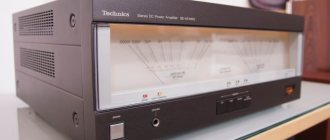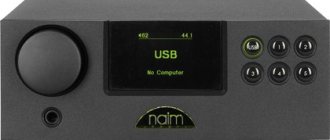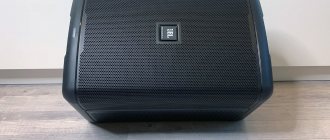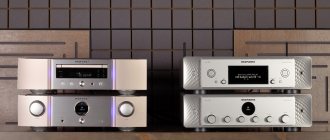Additional information for customers in the Russian Federation...
Pioneer home theaters
- Image
- Text
Additional information for customers in the Russian Federation
Certification Information
For models
N-30-K and N-30-S
For models
N-50-K and N-50-S
Pioneer N-50A Network Music Player Review: An Offer You Can't Refuse
Pioneer has a groovy and exceptionally rhythmic sound with seamless dynamics. The voices are expressive; It is worth noting the high quality of attack - the combination of energy and precision makes any music delightful.
Excellent detail and high purity ensure enviable meticulousness. Voices and instruments are precisely placed throughout the spacious and spacious music stage.
If you like to experiment with sound modes, you're in luck. The Hi-bit 32 Audio Processing mode increases the bit depth of the input signal, aiming to make its shape smoother, closer to analog. "Upsampling" raises it to 192 kHz; this can be called "artificial HD". The sound becomes more detailed, but more “sleek” and less dynamic.
To play low-quality files with strong compression, use the “Auto Sound Recovery” function. It also affects high-quality tracks: the sound becomes less clear, so it’s hardly worth using it.
We liked the “Direct” mode the most, which is enabled by default; with it, the audio signal does not undergo digital processing. The sound is cleaner, more precise and noticeably more rhythmic.
The metal body of the N-50A looks very high quality. We love the clean and modern brushed aluminum front panel. The N-50's color LCD display was too small; here it has increased to 3.5 inches. The color of the trim determines the model name: it is silver on the N-50A-S and black on the N-50A-K (K stands for “kuro,” or “black”).
In detail
1. Wireless
The N-50A does not have built-in wireless network support. You can buy a proprietary AS-WL300 adapter, connect it to the Ethernet connector, and it will receive power through this USB output.
2. Take control
If you have other Pioneer components (such as a CD player or amplifier), you can connect them here and control them all from the ControlApp.
The remote control pleases with conveniently located, responsive buttons. Smartphone owners can download a free application with the banal name ControlApp for Android and iOS. It is convenient for selecting compositions and viewing covers, but overall it is not fully thought out.
The Pioneer N-50A is exceptionally good; If you want a network player at a reasonable price, look no further. It boasts high sound quality and many useful functions. It is very difficult to surpass a two-time Award winner, but Pioneer managed to do it. We are absolutely delighted!
Price: $650
Grade: 5
PROS: Great sound; appearance; many functions; good app
CONS: Wireless adapters are not included; otherwise nothing
VERDICT: An excellent player has become even better - a clear success for Pioneer
WARNING To avoid fire, keep away from equipment...
Page 3
- Image
- Text
WARNING
To prevent fire, keep naked flame sources (such as lighted candles) away from the equipment.
D3-4-2-1-7a_A1_Ru
terms of Use
The product is operated at the following temperatures and humidity: +5 °C to +35 °C; humidity less than 85% (do not obstruct cooling fans) Do not install the product in a poorly ventilated area or in a location with high humidity that is exposed to direct sunlight (or strong artificial light).
D3-4-2-1-7c*_A1_Ru
If the product's power cord does not fit into your electrical outlet, replace the plug with one that is compatible with the outlet. Plug replacement and installation should only be performed by a qualified technician. A loose plug connected to an outlet may cause severe electric shock. After removing the plug, please dispose of it properly. The equipment should be disconnected from the electrical outlet by unplugging the power cord if it will not be used for an extended period of time (for example, if you are going on vacation).
D3-4-2-2-1a_A1_Ru
ATTENTION
Switch
/I STANDBY/ON
given
device does not completely disconnect it from the power supply. To completely turn off power to the device, unplug the power cord from the electrical outlet. Therefore, the device should be installed so that the power plug can be easily removed from the outlet in an emergency. To prevent fire, unplug the power cord from the electrical outlet if the device will not be used for a long period of time (for example, if you are going on vacation).
D3-4-2-2-2a*_A1_Ru
K041_A1_En
En Thank you for purchasing this Pioneer product. Wha...
Page 4
- Image
- Text
4
Ru
Thank you for purchasing this Pioneer product. To learn how to properly operate this model, please read these operating instructions. Once you have read the instructions, keep them in a safe place for future reference.
Content
01
Before starting work
Equipment . . . . . . . . . . . . . . . . . . . . . . . . . . . 5
Installing batteries in the remote control
.
. . . . . . . . . . . . . . . . . . . . . . . . . . . . 5 Using the remote control . . . . . . . . . . . . . . . . . . . . . . . . . . . . . . . 5
Remote control using iPod touch/iPhone/iPad . . . . . . . . . . . . . . . . . . . . . . . . 5
02
Connections
About the audio connection . . . . . . . . . . . . . . . . . . . . . 6
Connections for analog audio output
.
. 6 Digital audio connections
.
. . . . . . . . . . . . . 6 Connections for digital audio output . . . . . . . . 6
Connections for digital audio input
.
. . . . . . . . 6 Connecting the optional Bluetooth
®
7
Using a USB cable to connect to a computer
.
. . . . . . . . . . . . . . . . . . . . . . . . . . . . 7 Connect to the network via the LAN interface
.
. . 7 Connection using a LAN cable . . . . . . . . . . 7
Connection using LAN
.
. . . . . . . . . . 8 Connecting to the network . . . . . . . . . . . . . . . . . . . . . . . . 8
03
Part Names and Functions
Remote control . . . . . . . . . 9
Front Panel
.
. . . . . . . . . . . . . . . . . . . . . . 10 Display
.
. . . . . . . . . . . . . . . . . . . . . . . . . . . . . . 10 04
Basic playback
Beginning of work . . . . . . . . . . . . . . . . . . . . . . . . . 11
Playback from iPod/iPhone/iPad
.
. . . . . . 11 Check which iPod/iPhone/iPad models are supported . . . . . . . . . . . . . . . . . . . . . . . . . . eleven
Playback from iPod/iPhone/iPad
.
. . . . . . . . . . 11 Playing files stored on USB storage devices . . . . . . . . . . 12
05
Play
Bluetooth® Audio
(
option)
Play music using Bluetooth
.
. . . . . . .13 Using the remote control . . . . . 13
Connecting the optional Bluetooth
®
.
. . . . . . . . . . . . . . . . . . . . . . . . . . . . 13 Setting a PIN code
.
. . . . . . . . . . . . . . . . . . . . .13 Pairing the
Bluetooth
® adapter and a device equipped with
Bluetooth .
. . . . . . . . . . . . . . . . . . . . . . . . . . . . . . 14 Listening to music data from a device equipped with
Bluetooth .
. . . . . . . . . . . . . . . . . . .14 AIR JAM
.
. . . . . . . . . . . . . . . . . . . . . . . . . . . . . . 14 06
Internet radio
Listening to Internet radio . . . . . . . . . . .15
LAN connection. . . . . . . . . . . 15
Listening to Internet radio for the first time
.
. . . . . . 15 Tuning into a radio station
.
. . . . . . . . . . . . . . . . 15 Adding radio stations to your Favorites list . . . . . . . . . . . . . . . . . . . . . . . . . . . . . . . 15
Removing radio stations from the list. . . . . . . . . . . . . 15
Advanced Operations for Internet Radio . . . . . . . . . . . . . . . . . . . . . . . . .15
Registering broadcast stations not on the vTuner list from Pioneer's dedicated website . . . . . . . . . . . . . . . . . . . . . . . . . . . . . . . . . 15
07
Music server
Introduction . . . . . . . . . . . . . . . . . . . . . . . . . . . . . .17
About playable DLNA network devices . . . . . . . . . . . . . . . . . . . . . . . . . . . . . . . . . . 17
Use AirPlay on iPod touch, iPhone, iPad and iTunes
.
. . . . . . . . . . . . . . . . . . . . . . . . . . . . . . . . . 17 About the DHCP server function
.
. . . . . . . . . . . . . . . . . . 17 Authorization of this device
.
. . . . . . . . . . . . 17 Play audio files stored on computers or other components . . . . . . .17
LAN connection. . . . . . . . . . . 17
Playback via Music Server
. . . . . . . . . . . . . . . . . . . . . . . . . . . . . . . . . 17
08
Using other features
Using Sound mode . . . . . . . . . . . . . . . . . . . . . . . . . . . . . . . . . 19
For greater accuracy in recreating the original sound
.
. . . . . . . . . . . . . . . . 19 Using a digital-to-analog converter
.
. . . . . . . . . . . . . . . . . . . . . . 19 Playing music from a digital audio component . . . . . . . . . . . . . . . . . . . . . . . . . 19
Playing music from your computer
. . . . . . . . 19
09
Changing settings
Network setting (
Network configuration). . . . . . . . . . . 20
Friendly Name . . . . . . . . . . . . . . . . . . . . . . . . . . 21
Setting up parental controls
.
. . . . . . . 21 Enable/disable parental controls . . . . . . . . . . . . . . . . . . . . . . . . . . . . . . . . 21
Change Password
.
. . . . . . . . . . . . . . . . . . . . . . . . 21 Software update . . . . 21
Error messages when updating software . . . . . . . . . . . . . . . . . . 21
Power Off Settings . . . . . . . . . . . 21
Changing the Auto Power Off setting . . . . . . . . . . . . . . . . . . . . . . . 21
Changing the Quick Start Mode
.
. . . . . . . . . . . . . . . . . . . . . . . . . . . . . . . . . . 21 Reset system settings . . . . . . . . . . . . . . . . . 21
Error messages when updating software . . . . . . . . . . . . . . . . . . 21
Power Off Settings . . . . . . . . . . . 21
Changing the Auto Power Off setting . . . . . . . . . . . . . . . . . . . . . . . 21
Changing the Quick Start Mode
.
. . . . . . . . . . . . . . . . . . . . . . . . . . . . . . . . . . 21 Reset system settings . . . . . . . . . . . . . . . . . 21
10
Additional Information
Troubleshooting . . . . . . . . . . . .22
Playable file formats
.
. . . . . . .26 Precautions during operation
.
. . . . . . . . . . . . . . . . . . . . . . . . . .26 When moving the device . . . . . . . . . . . . . . . .26
Installation location
.
. . . . . . . . . . . . . . . . . . . . . . . . .26 Do not place objects on the device
.
. . . . . . .26 Cleaning the product
.
. . . . . . . . . . . . . . . . . . . . . . . . . .27 About network playback . . . . . . . . . . . . . . .27
Windows Media Player . . . . . . . . . . . . . . . . . . . . . .27
Windows Media DRM
.
. . . . . . . . . . . . . . . . . . . . . .27 DLNA
.
. . . . . . . . . . . . . . . . . . . . . . . . . . . . . . . . .27 Content played over the network
.
. . . . . . . . .27 Third Party Content Disclaimer
.
. . . . . . . . . . . . . . . . . . . . . . . . . .27 About the characteristic properties of playback via the network
.
. . . . . . . . . . . . . . . . . . . . . . . . . . . . . . . . . . .27 Authorization of this device
.
. . . . . . . . . . . . .27 aacPlus
.
. . . . . . . . . . . . . . . . . . . . . . . . . . . . . . . . .28FLAC
.
_ . . . . . . . . . . . . . . . . . . . . . . . . . . . . . . . . . .28 About iPod/iPhone/iPad devices . . . . . . . . . . .28
Specifications
. . . . . . . . . . . . . .28
network audio player Pioneer N-50-K
CD sales have been steadily declining for years. Representatives of the record industry blame all their troubles on pirates, although in fact the reason is different. The digital genie, which for several decades was a slave to the lamp, that is, the CD, has broken free - the Internet and computers have set it free. It won’t be possible to drive him back, but it’s quite possible to come to an agreement and make him your ally.
Plays: LPCM, WAV, FLAC, mp3, AAC, WMA | DAC: 32bit/192kHz | Network playback: yes (up to 24bit/192kHz) | Network protocols: AirPlay, DLNA v1.5 | Bluetooth: yes (optional, via AS-BT200 adapter) | Internet radio: yes | Control from Apple/Android devices: yes/yes | Over-the-air tuner: no | USB playback: yes (up to 24bit/96kHz) | Outputs: analog 2 x RCA, digital optical and coaxial | Inputs: digital optical and coaxial, USB | Network: Ethernet 100 Mbit, Wi-Fi (optional, using AS-WL300 adapter) | USB Interface: USB A x2, USB B x1 | Dimensions: 435 x 99 x 330 mm | Weight: 7.3 kg | Price: 23990 rub.
Before our eyes, another change in the sound reproduction paradigm is taking place. The production of “pure” CD players is being reduced - their place is taken by station wagons, for which the CD Audio format is among the supported ones, but is not the main one. At the same time, the production of music players without a disk drive at all, but with a network adapter, is growing. Similar devices have been produced before, but they have never been mass-produced, just like specialized computers optimized for music playback. The turning point occurred in 2010 - it was then that relatively inexpensive network players began to appear, aimed at demanding music lovers.
As has happened more than once, the first models were not very successful - the market was not yet ready for new music sources, and the developers did not have sufficient experience. As a result, those who rushed and got burned by milk are now blowing their minds, that is, they are in no hurry to release new models. The cautious ones won.
Information about the release of Pioneer network players has been discussed in online forums since the very beginning of this year, and although devices from other brands were already on sale, many decided to wait for equipment from a reputable Japanese brand and only then make a purchasing decision. Well, let's see how these expectations came true.
AT AN ARM DISTANCE
A metal front panel with a rough (brushed) surface, a large Power button with an LED indicator in the center - all these elements of corporate identity have already contributed to the popularity of Pioneer DVD and Blu-ray players. The USB connector located on the left is capable of delivering up to 2.1 A of supply current to the drives connected to it, which is many times greater than the limit set by the USB 2.0 specification. This current is enough even for portable HDDs. The same connector is also designed for playing music from portable Apple devices, and control is transferred to the network player. Charging is carried out in parallel. It is also possible to play music from Apple devices using the AirPlay wireless protocol.
There are two USB interfaces on the rear panel: one type A (you can connect the optional AS-WL300 Wi-Fi adapter to it) and B - for connecting to a computer and implementing the USB DAC function, it is designated as Digital In. A separate dedicated connector is provided for the separately purchased AS-BT200 Bluetooth adapter.
LCD display - with QVGA resolution, color, it displays the settings menu, source selection, as well as information about the tracks being played, including photos of disc covers. However, the 2.4" diagonal is too small to perceive the information displayed on the display directly from your chair - you will have to approach the device. Or use the free ControlApp application for portable devices on iOS or Android, although it does not display cover photos at all, so it is not able to replace the display. By the way, in both markets (iOS and Android) there is another branded free application - Air Jam. With its help, you can create shared playlists from music that is stored on portable players and smartphones of different party participants.
The transport control buttons on the front panel are also designed to navigate through the menu, which is not very convenient. By the way, Pioneer DVD and Blu-ray players implement all this much more successfully. But the remote control is convenient and visually attractive, there are no complaints about it.
EVEN MORE BITS
Before moving on to listening, I’ll tell you about the internal structure of the player. It is known that the power and control units, analog and digital parts of the circuit are made on separate boards; moreover, the analog module is powered by its own stabilizer with a personal transformer.
You can turn off the display with a separate button on the remote control if you suspect that it is causing interference. In addition, it is possible to route the signal through the shortest path, bypassing DSP - this is the Pure Audio function, activated by a separate button from the remote control. There is an indicator on the front panel showing its activity. Nearby is another LED with the inscription “Hi-Bit 32”. This function is implemented in DSP, so it cannot work simultaneously with Pure Audio. Its essence is to increase the bit depth of the digital signal from 16 or 24 to 32 bits. As you can easily guess, the DAC, which is capable of working with signals up to 192 kHz, has exactly the same bit rate, but what chip it is built on is not indicated in the documentation.
Another processing is Auto Level Control - automatic level alignment for different recordings. May be useful for listening at low volume levels, for example, late at night.
The analog outputs are just regular RCA, but they are durable and spaced wide enough from each other to allow you to connect serious cables to them. There are digital inputs - optical, coaxial and the already mentioned USB, so the device can be used as an external DAC. Or transport - there are both digital outputs.
The device is prepared for use in Russia - this is manifested not only in the user manual in our language, but also in the presence of the country in the list of Internet radio regions. Accordingly, there are a lot of domestic stations in it. The “reception” quality is normal - in the sense that lossy compressed streams are decoded with decent quality. Moreover, their sound can be further improved by enabling Auto Sound Retriever processing.
The USB interface on the rear panel is capable of operating with a sampling frequency of up to 192 kHz (after downloading a USB driver to the computer from the Pioneer website), but the one located on the front panel and designed for connecting external drives is only up to 96 kHz/24 bit. The restriction, in my opinion, is strange. More often it happens the other way around.
Over the network, the player plays 192 kHz/24-bit files without any problems. In this case, the well-known DLNA 1.5 protocol is used. By the way, Pioneer was one of the first to support it in AV equipment.
GAPS IN THE WALL
Well, now let's listen to the music. The reference source is an external PS Audio PerfectWave DAC MkII with computer transport. We play FLAC files located on the local network.
N-50-K plays neutrally and calmly. Sometimes it even seems that it’s a little slower than the reference, although he doesn’t have a particularly hot temperament. Compression is noticeable on symphonic pieces (the Auto Level Control function is deactivated), however, this was characteristic of almost all network players that we tested. When the Pure Audio function is activated, the sound is noticeably purified, digital “roughness” and the feeling of slowness go away. But the effect of Hi-Bit 32 seemed unobvious to me, although I can clearly hear the difference between 16 and 24 bit recordings. Differences from the reference are noticeable mainly in the bass - in the DAC they are denser, clearer and deeper. The only disappointment is that if you play a continuous album (for example, “The Wall” by Pink Floyd) in the form of track-by-track files, the device adds a short pause between them. You can, of course, combine individual tracks into a common FLAC image, but navigation through it will be impossible, since the player does not understand CUE files.
Of course, the device still needs to warm up properly, but almost out of the box it plays surprisingly well. However, why be surprised here - everything was done competently, with knowledge of the matter.
pleased
Sounds good. Reads Hi-Res files over the network with a bit depth of up to 24 bits/192 kHz. There are useful functions Sound Retriever and Auto Level Control, and the display can be turned off.
upset
Does not play 24-bit/192 kHz files from the front USB connector. Small display. There are no separate menu navigation buttons on the front panel. Adds a pause between tracks. The portable app does not display disc covers.
share
Tags: Pioneer









